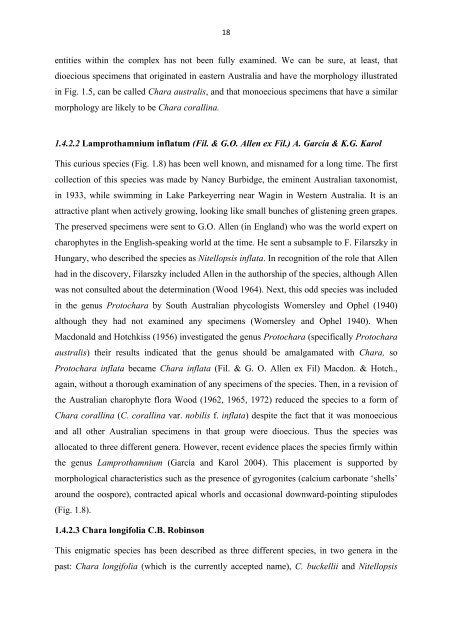Chapter 1: The Characeae Plant
Chapter 1: The Characeae Plant
Chapter 1: The Characeae Plant
You also want an ePaper? Increase the reach of your titles
YUMPU automatically turns print PDFs into web optimized ePapers that Google loves.
18 <br />
entities within the complex has not been fully examined. We can be sure, at least, that<br />
dioecious specimens that originated in eastern Australia and have the morphology illustrated<br />
in Fig. 1.5, can be called Chara australis, and that monoecious specimens that have a similar<br />
morphology are likely to be Chara corallina.<br />
1.4.2.2 Lamprothamnium inflatum (Fil. & G.O. Allen ex Fil.) A. García & K.G. Karol<br />
This curious species (Fig. 1.8) has been well known, and misnamed for a long time. <strong>The</strong> first<br />
collection of this species was made by Nancy Burbidge, the eminent Australian taxonomist,<br />
in 1933, while swimming in Lake Parkeyerring near Wagin in Western Australia. It is an<br />
attractive plant when actively growing, looking like small bunches of glistening green grapes.<br />
<strong>The</strong> preserved specimens were sent to G.O. Allen (in England) who was the world expert on<br />
charophytes in the English-speaking world at the time. He sent a subsample to F. Filarszky in<br />
Hungary, who described the species as Nitellopsis inflata. In recognition of the role that Allen<br />
had in the discovery, Filarszky included Allen in the authorship of the species, although Allen<br />
was not consulted about the determination (Wood 1964). Next, this odd species was included<br />
in the genus Protochara by South Australian phycologists Womersley and Ophel (1940)<br />
although they had not examined any specimens (Womersley and Ophel 1940). When<br />
Macdonald and Hotchkiss (1956) investigated the genus Protochara (specifically Protochara<br />
australis) their results indicated that the genus should be amalgamated with Chara, so<br />
Protochara inflata became Chara inflata (Fil. & G. O. Allen ex Fil) Macdon. & Hotch.,<br />
again, without a thorough examination of any specimens of the species. <strong>The</strong>n, in a revision of<br />
the Australian charophyte flora Wood (1962, 1965, 1972) reduced the species to a form of<br />
Chara corallina (C. corallina var. nobilis f. inflata) despite the fact that it was monoecious<br />
and all other Australian specimens in that group were dioecious. Thus the species was<br />
allocated to three different genera. However, recent evidence places the species firmly within<br />
the genus Lamprothamnium (García and Karol 2004). This placement is supported by<br />
morphological characteristics such as the presence of gyrogonites (calcium carbonate ‘shells’<br />
around the oospore), contracted apical whorls and occasional downward-pointing stipulodes<br />
(Fig. 1.8).<br />
1.4.2.3 Chara longifolia C.B. Robinson<br />
This enigmatic species has been described as three different species, in two genera in the<br />
past: Chara longifolia (which is the currently accepted name), C. buckellii and Nitellopsis
















